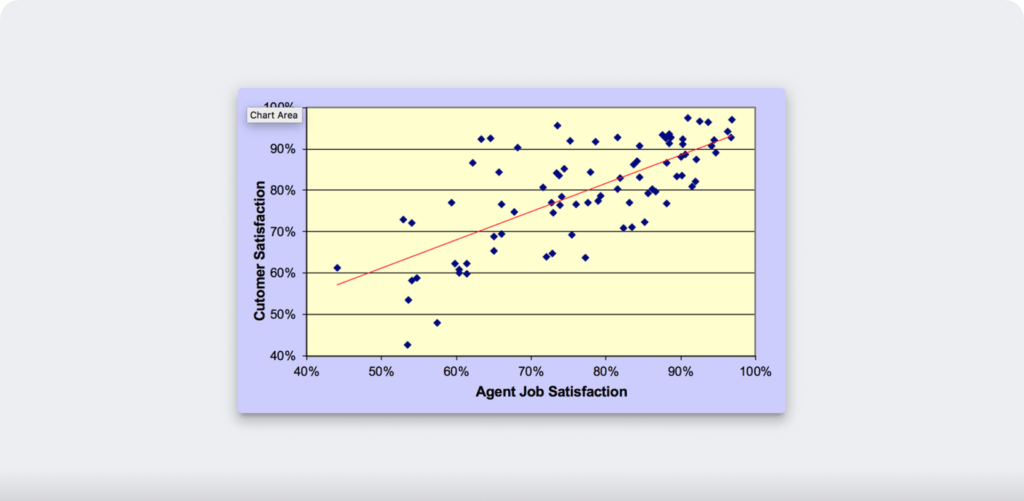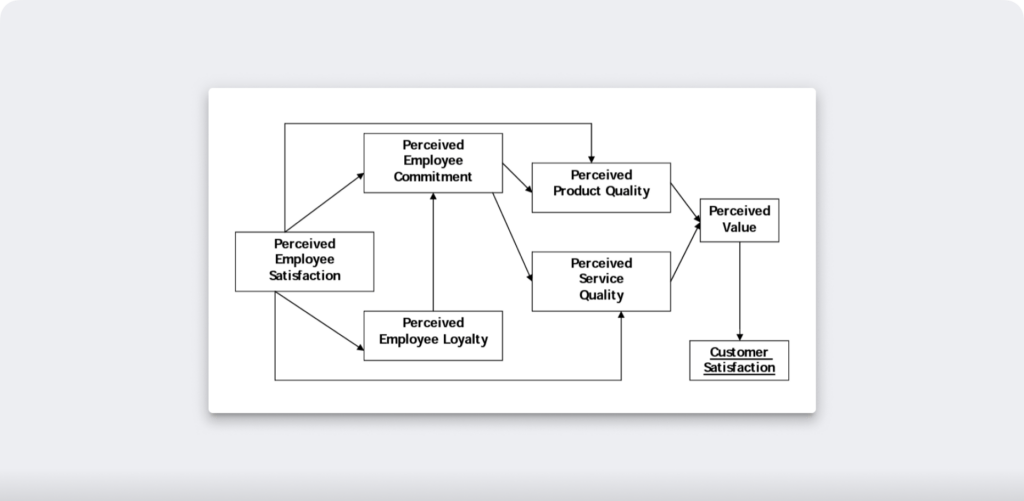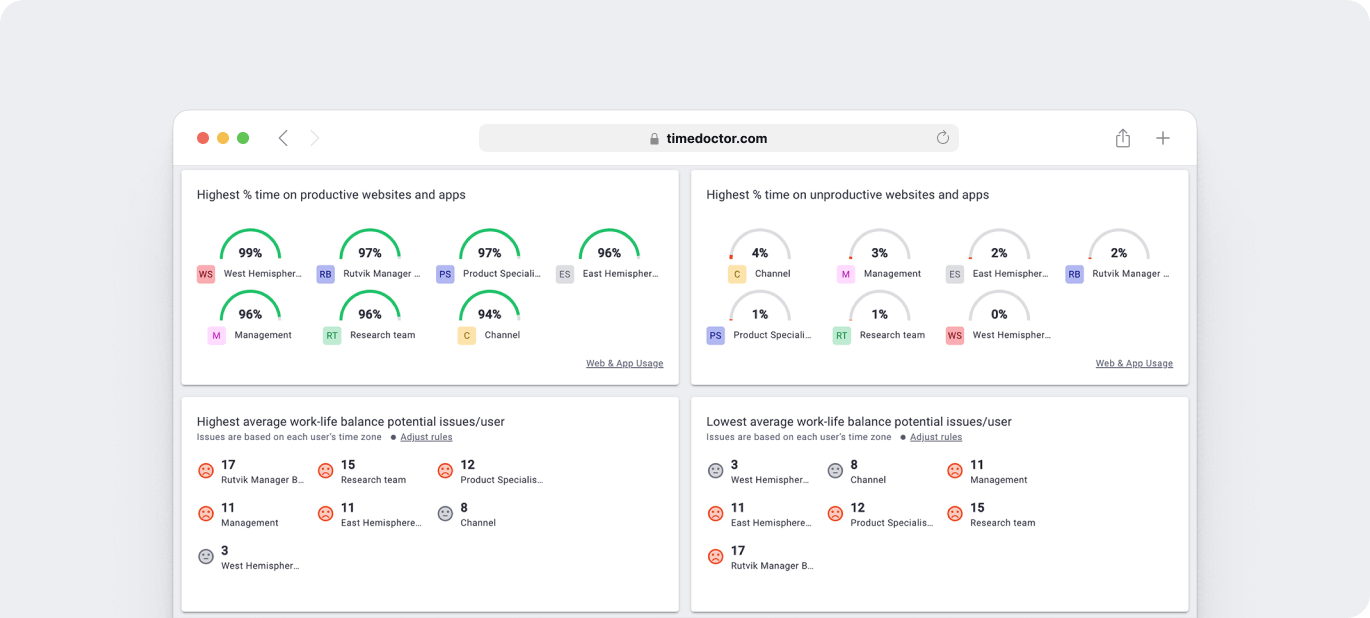We all know the famous saying: “What gets measured gets managed.”
But resources are finite, so you can only monitor KPIs (Key Performance Indicators) for some things in your business. You need to choose what gets measured and what gets managed wisely.
This article will argue that employee satisfaction is one of the most critical metrics. And that any business looking to grow and satisfy its customers should be measuring it as a priority.
We will also put forward several methods for tracking and analyzing employee satisfaction and then using that information to improve the overall performance of your business.
The impact of employee satisfaction on your business
Which has more of an impact on your bottom line: employee satisfaction or customer satisfaction?
The truth is that both do. Customer satisfaction and loyalty have a direct effect on profitability. And employee satisfaction has been shown to directly impact customer satisfaction.
For example, a classic study at Sears Roebuck & Co., reported in the Harvard Business Review, showed that a 5% increase in employee satisfaction led to a 1.3% improvement in customer satisfaction, which generated a 0.5% increase in revenue.
A study by ICMI plotted customer satisfaction scores against employee satisfaction scores and found a compelling correlation between the two:

Vilares and Cohelo (2000) suggested this is because customers read all sorts of factors into employee satisfaction, including the perceived quality of your product or service and the perceived value you are offering:

The operational impact of employee satisfaction
Employees’ level of engagement and satisfaction also impacts operational and productivity metrics. The same ICMI report finds a correlation between employee turnover and satisfaction. Put simply, more engaged employees are less likely to quit – an essential advantage in today’s tight job market where keeping hold of talent is more difficult than ever.
A McKinsey report suggests that an engaged employee is a whopping 8.5 times more likely to stay with their employer and 16 times more likely to recommend them to a friend.
Finally, Gallup’s Employee Engagement Survey found a whole plethora of indicators are impacted by employee satisfaction:
- When employees are engaged, productivity sees a 14% uptick.
- Fully committed employees can bring an 18% boost in sales.
- A rise in productivity can lead to as much as 23% profit growth.
- Engaged employees give a 10% increase in customer loyalty and engagement.
Of course, engaged and happy employees do more than boost productivity, customer satisfaction, and profits; they shape a vibrant company culture. This creates a virtuous cycle in which your employees become your biggest advocates and help you recruit more like-minded and engaged employees, further reinforcing the impact that high levels of employee satisfaction can have on your business.
Why you need to measure employee satisfaction
At its core, employee satisfaction reflects the happiness and contentment employees get from their roles. It depends on many factors, including the organization’s ethos, work-life balance, job stability, avenues for growth, acknowledgment and recognition, and the openness of communication.
So, while measuring employee satisfaction in its own right is essential, it’s even more crucial to understand it within the context of your business so that you can see how it impacts other performance indicators. We have already seen how employee satisfaction impacts customer satisfaction, but it has a much wider impact too.
Link to employee engagement and retention
Insights from employee engagement platform Officevibe demonstrate the correlation between employee satisfaction and retention. Businesses that place a premium on employee well-being tend to have a magnetic pull, retaining top-tier talent, which in turn amplifies customer satisfaction. Periodic assessments of employee satisfaction empower businesses to spotlight parts of their culture that may need nurturing a little.
Impact on productivity
As we have already seen, happy and invigorated employees naturally show higher commitment and efficiency. A study by BambooHR suggests that employees brimming with satisfaction outperform their less enthusiastic peers by a staggering 38%. By keeping a pulse on employee satisfaction, businesses can understand what drives individual productivity and identify areas ripe for improvement.
Influence on company culture
Employee satisfaction is instrumental in defining an organization’s culture. When employees feel cherished and perceive a sense of camaraderie in a nurturing environment, they naturally infuse positivity into the company’s DNA. There is a definite bilateral relationship between culture and satisfaction. Culture can negatively or positively impact satisfaction, and employee satisfaction levels can return the favor and exacerbate an already poor culture or contribute towards a positive one. As Gallup’s Q12 survey into employee satisfaction states: “When we measure engagement, we’re measuring employees’ involvement in and enthusiasm for their work and workplace.”
Employee branding and employee advocacy
Happy employees can be more than just members of a workforce; they become brand custodians. Employees who are satisfied with their work are more predisposed to vouch for your company, helping you to attract more talent through referrals and advocacy. Officevibe’s data suggests that 90% of employees, when they perceive organizational support for their well-being, are inclined to champion their company. Businesses can fine-tune their brand appeal by keeping a finger on the pulse of employee satisfaction.
How to measure employee satisfaction
Now that we know why measuring employee satisfaction is important and what indicators it might impact, let’s look at exactly how to do it. As you can imagine, many ways exist to collect and analyze employee satisfaction data.
We all instinctively know that happy employees translate into stronger business performance. But how can you accurately gauge satisfaction levels across your workforce and demonstrate what impact these have on other business indicators? It requires a strategic approach versus haphazard one-off surveys. Here are proven methods to quantify the employee experience at your organization:
Conduct Frequent Pulse Surveys
Short, anonymous pulse surveys on a regular cadence (monthly or quarterly) will uncover employee sentiment as it constantly evolves. Understanding how it changes over time is much more important than just taking a single snapshot once or twice a year. Putting a survey in place is a whole program of works in itself – below, we look at how to do it more in-depth.
How to run an Employee Satisfaction Survey program
Clearly define your goals – What do you want to learn? Are you diagnosing a specific issue or benchmarking engagement more broadly? Establish focus upfront.
Prioritize anonymity – Employees will provide more honest, critical feedback when surveys are anonymous. But allow respondents to self-identify if they want follow-up conversations.
Ask targeted questions – Well-crafted questions aligned to survey goals elicit meaningful insights versus generic job satisfaction queries. You need to create an employee satisfaction index consisting of hand-picked questions that calibrate overall engagement. Rated from 1 to 5, each question captures distinct facets of employee mindset. Example questions include:
- What is your workplace happiness, from 1 to 5?
- Are you proud of your employer’s business? Their products and services?
- Morning motivation – how do you feel getting ready to come to work?
- How positively do you view your colleagues? Your bosses?
- Are you willing to advocate for your company to friends?
- How would you rate the whole experience of your employment?
These questions should encourage employees to divulge details about job sentiment, culture, camaraderie, and governance. You attain a multifaceted view of your strengths and weaknesses by embedding these into your survey. You establish a yardstick for assessing any future initiatives.
Blend quantitative and qualitative – Be sure to include multiple choice questions to derive a score and open-ended fields to capture anecdotal feedback.
Establish cadence and length – Frequent short pulse surveys often outperform marathon annual reviews. Avoid survey fatigue.
Promote two-way dialogue – Share key takeaways and commit to acting on feedback. Surveys should spark ongoing conversations.
Close the loop – Follow up on implemented changes so employees know they are heard. This builds trust and engagement.
Complement with other listening tools – Stay interviews (like exit interviews, but with employees that are staying), roundtables, and casual office observations add helpful nuance to survey data.
Analyze results by segments – Slice data by tenure, role, team, etc., to uncover diverging trends and needs by subgroup.
Track over time – Monitor engagement metrics consistently to spot evolving trends and gauge the impact of initiatives.
Compare benchmark data – Industry average scores provide context for your results and help identify competitive strengths/weaknesses.
Thank participants – Express genuine appreciation to survey takers for dedicating their time and thought to help improve their workplace.
Have a plan to act – Don’t administer a survey without commitment from leadership to take action on findings. Employees want change, not more data.
Other methods for tracking employee satisfaction
Benchmark Key Performance Indicators – Metrics like eNPS (Employee Net Promoter Score) and ESI (Employee Satisfaction Index), which you can derive from survey data, put a number to satisfaction. Track these KPIs over time to spot trends and compare them against industry benchmarks. Sudden drops in scores demand an investigation.
Interview Team Members – Nothing beats having candid one-on-one conversations with employees. Periodic interviews let managers dive deeper into individual perspectives and ideas for improvement. This face time builds trust and community.
Open Feedback Channels – Give employees a voice through always-on feedback platforms. Anonymous digital suggestion boxes make it safe to speak up. Reiterate that all ideas will be reviewed and addressed by leadership.
Analyze Exit Interviews – Understand why employees leave by asking them upon departure. Look for patterns around management, work environment, or growth opportunities needing change. Just beware that exiting employees may not share fully candid thoughts.
Observe Office Culture – Managers can learn a lot just by walking the halls and observing team dynamics. Low energy, lack of collaboration, and empty offices are red flags of sinking engagement. But beware of drawing conclusions based on observation alone.
Leverage AI Tools – combine analytics with observational data. AI and data mining tools can automatically surface “hot spots” of declining sentiment, alerting managers in real-time.
While measurement provides the necessary data, acting on the findings is where the impact happens. Start by sharing results with employees to reinforce transparency. Then, collaboratively brainstorm and implement changes to move the needle.
By taking a systematic approach to gauging satisfaction backed by actions, you gain an incredible advantage in boosting performance and retaining talent. Don’t leave this crucial metric to chance.
The role of Time Doctor in enhancing employee satisfaction

Time tracking tools like Time Doctor provide invaluable visibility into employee workflows, engagement, and productivity. Specifically, Time Doctor enables organizations to:
- Precisely track employee work hours and identify overburdened staff at risk of burnout. Managers can course-correct heavy workloads before satisfaction suffers.
- Monitor time spent on specific tasks to pinpoint workflow inefficiencies that frustrate employees. Smoothing these pain points directly improves satisfaction.
- Enable flexible scheduling and remote work while maintaining oversight of employee productivity. This autonomy further promotes work-life balance.
- Set reminders for regular breaks and off-work hours. Employees feel empowered to recharge and do their best work.
- Gain data to correlate engagement levels with the amount of time spent on critical tasks. Insights can be used to optimize operations.
- Provide employees transparency into their own time use and productivity patterns for self-improvement.
- Combining time data with pulse surveys gives managers a powerful mix of quantitative and qualitative insights into the employee experience.
- Track satisfaction KPIs like eNPS over time to gauge the impact of new policies and workflows on engagement.
- With holistic insights enabled by tools like Time Doctor, organizations can proactively identify and resolve engagement blockers before employee satisfaction suffers. The result is an empowered, productive workforce and a stronger bottom line.
Measuring employee satisfaction is not just a good-to-have; it’s necessary in today’s competitive business environment. Companies can foster a positive work culture by understanding and addressing employee needs and concerns. Tools like Time Doctor can provide valuable insights into employee work patterns, helping managers make informed decisions to boost satisfaction levels, enhance productivity, retain top talent, and create a positive work environment that drives success.

Carlo Borja is the Content Marketing Manager of Time Doctor, a workforce analytics software for distributed teams. He is a remote work advocate, a father and an avid coffee drinker.


